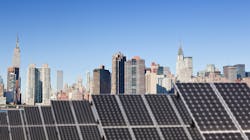New York Power Authority Completes Weather Forecasting Study for Solar
The New York Power Authority (NYPA) and its research partners have completed a multi-year study to help New York State’s growing solar industry deploy weather forecasting technology to better anticipate power generation and improve electric grid reliability. The project addresses challenges raised by the uncertainty related to solar output by offering advanced forecasting methods and making a roadmap to help maintain grid reliability, optimize production of renewables, and reduce operating costs. The technology informs and will help advance New York State’s goal of at least 10 gigawatts (GW) of distributed solar by 2030 and move New York closer to its goal of 70% renewable generation by 2030 and a zero-emission electricity sector by 2040.
“As solar systems become more widespread in New York State, high quality weather forecasting models will be vital to the operations of utilities and independent system operators,” said Alan Ettlinger, senior director of the New York Power Authority’s Research, Technology Development and Innovation team. “The New York Power Authority team was able to show how more extensive data and advanced solar-focused models increase the degree of accuracy and granularity that will be needed to maintain grid reliability and support operations.”
The study, the final $1.5 million phase of a $2.4 million project, lays out lessons learned for how forecasting can be deployed, improved and integrated into New York State to allow grid operations to remain effective as solar becomes more integral to day-to-day grid operations.
The research was funded by NYPA, the New York State Energy Research and Development Authority (NYSERDA), and the U.S. Department of Energy Solar Energy Technologies Office, and co-managed by EPRI, an independent, non-profit energy R&D institute. Other partners included National Center for Atmospheric Research (NCAR), Brookhaven National Lab (BNL) and the State University of New York at Albany. Advisors included the New York Independent System Operator (NYISO) and Central Hudson, a New York distribution utility.
Forecasting Systems Track Sun’s Energy Potential for State Energy Grid
BNL with assistance from the University of Albany, deployed high-definition digital cameras in sky-imager networks and advanced weather forecasting models focused on solar forecasting, combined with advanced data from the NYS Mesonet, a statewide network of weather stations, and other resources. Advanced predictive methods, along with various hardware and software systems, were developed and evaluated against forecasts currently in use to show the benefits of more detailed models and data.
The study relied on an open-source, gridded solar power forecasting system developed by scientists at NCAR. NYSolarCast makes predictions of global horizontal irradiance (GHI) every 15 minutes for a three-kilometer grid covering all of New York, which are then used to predict solar power generation for both utility-scale photovoltaic (PV) plants and distributed (mostly rooftop) PV installations. NYSolarCast leverages machine learning techniques trained on NCAR-based weather prediction models, NYS Mesonet observations and historical data from PV plants across New York.
The study helped develop an underlying platform for solar and other utility-related weather forecasting, including building load management, based on improved solar irradiance forecasts. However, results indicated that the solar industry needs to acknowledge the need for growth and take steps to be more transparent by sharing data, having better maintenance and monitoring instrumentation, and filtering out erroneous data.
The research identified several possible ways the forecast models could be deployed and the feasibility of each: incorporation of research by a forecast provider, public deployment, or deployment by a private entity.
The new models could also form the basis of improved commercial tools. Several companies currently provide forecasting services for New York State, particularly for day ahead operations based on weather modeling. Improved forecasts could be applied to individual solar plants and to predict distributed solar across a large region, not only for NYISO, but also for generation, transmission and distribution companies, private developers, and end user customers.
“Efficiently and rapidly integrating and operating DERs, like solar photovoltaics, pose several challenges and opportunities,” said Daniel Brooks, EPRI’s vice president of Integrated Grid and Energy Systems. “Incorporating these grid-edge resources into overall grid operations through improved solar forecasting solutions is vital to their success. We’re pleased to work with these collaborators to help improve the reliability and resilience of New York’s grid operations and beyond.”
Read the report here.
